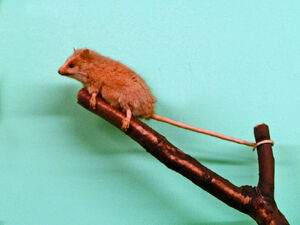| This page uses Creative Commons Licensed content from Wikipedia (view authors). |
| Brazilian Gracile Opossum | |||
|---|---|---|---|

| |||
| General information | |||
| Universe | Real Life | ||
| Classification | Gracilinanus microtarsus | ||
| Species type | Gracile Mouse Opossum | ||
| Homeworld | Earth | ||
| Environment | Brazil: Rainforests and partially deciduous forests | ||
| Intelligence | Non-Sapient | ||
| Biochemistry | Carbon-based lifeform | ||
| Biological information | |||
| Lifespan | 2 years (most survive only for just over a year) | ||
| Reproduction | Sexual; give live birth | ||
| Average weight | ♂ 17 to 52 grams (0.60 to 1.83 oz) ♀ 12 to 37 grams (0.42 to 1.31 oz) | ||
| Average length | Head-Body: ♂ 86 to 129 centimetres (34 to 51 in) ♀ 81 to 116 centimetres (32 to 46 in) | ||
| Locomotion | Quadrupedal | ||
| Feeding behavior | Insectivore | ||
| Prey | Insects, spiders, snails, fruit including passionfruit | ||
| Predators | ocelots, oncillas, crab-eating foxes, maned wolves and white-tailed hawks. | ||
| Lineage information | |||
| Cultural information | |||
| Alignment | Neutral | ||
| Personality | Nocturnal opportunistic forager | ||
| Organization | Solitary | ||
| Sociocultral characteristics | |||
| Scientific taxonomy | |||
| Planet | Earth | ||
| Domain | Eukaryota | ||
| Kingdom | Animalia | ||
| Subkingdom | Eumetazoa | ||
| Infrakingdom | Bilateria | ||
| Superphylum | Deuterostomia | ||
| Phylum | Chordata | ||
| Subphylum | Vertebrata | ||
| Infraphylum | Gnathostomata | ||
| Superclass | Tetrapoda | ||
| Class | Mammalia | ||
| Order | Didelphimorphia | ||
| Family | Didelphidae | ||
| Genus | Gracilinanus | ||
| Species | microtarsus | ||
| Other information | |||
| Status | Least Concern | ||
The Brazilian gracile opossum, Gracilinanus microtarsus, is a species of small opossum from Brazil.
Description[]
Brazilian gracile opossums are relatively small opossums, with males ranging from 86 to 129 centimetres (34 to 51 in) and females from 81 to 116 centimetres (32 to 46 in) in head-body length. The tail is between 30 and 50% of the head-body length. Males weigh 17 to 52 grams (0.60 to 1.83 oz) and females from 12 to 37 grams (0.42 to 1.31 oz).
The opossum is reddish dark brown or gray over most of its body with paler, cream-colored underparts. The fur on the face is also relatively pale, with distinct rings of near black fur around each eye. The tail is prehensile and scaly, and does not store fat as it does in some related species. The toes are relatively long, with small, regular claws. The female typically has fifteen teats, although the exact number can vary; four are on the chest, and the remainder, including a single median teat, on the abdomen.
Distribution and habitat[]
The Brazilian gracile opossum is found only in Brazil, being endemic to the south-eastern parts of the country, from Espirito Santo to Rio Grande do Sul. It inhabits rainforests and partly deciduous forests scattered in the southern regions of the cerrado ecoregion, but, being able to forage successfully on the ground, is less affected by fragmentation of forest habitats than more purely arboreal animals. It has also been found in artificial plantations.
There are no recognized subspecies.
Behavior[]
Brazilian gracile opossums are arboreal and nocturnal, spending the day nesting in tree hollows. They are solitary animals, with each individual inhabiting a home range of anything from 0.03 to 0.32 hectares (0.074 to 0.791 acres), depending on habitat. Males tend to have larger home ranges than females, presumably because, being larger, they require more food.
The species is insectivorous, and is an opportunistic forager, not specializing in any particular kind of insect. Individuals have also been reported to eat some spiders, snails, and even fruit (including passionfruit). Predators of Brazilian gracile opossums include ocelots, oncillas, crab-eating foxes, maned wolves and white-tailed hawks.
Reproduction[]
Females come into estrus once a year, between August and September. Litters of up to twelve young are born during the wet season, when food is plentiful. The mother does not possess a pouch. They are weaned by three months of age, between November and December. The young are fully grown, with an adult set of teeth, by six months, reaching sexual maturity within a year of birth. Most Brazilian gracile opossums do not survive for much longer than a year, but some can reach two years of age.